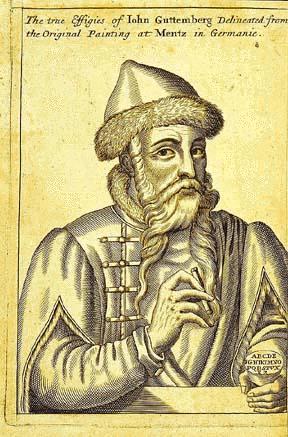Have you ever
wondered how ideas went from being spoken to being written in books?
Johannes
Gutenberg is part of the answer.
Gutenberg was
born in 1398 to a well-off family in the city of Mainz, Germany. His full
name was Johannes Gensfleisch zur Laden zu Gutenberg. His father,
Friele,
and his uncle were officials at the Archbishop's mint. After training to
be a goldsmith, he moved to Strasbourg, Germany in 1428, where he made his first attempts at
type-setting.
Lets back up for a moment and firstlook at the state of b
ooks before Gutenberg. Starting in 868 AD with
the Diamond Sutra,
the Chinese carved books into wood blocks; the process of carving into
wood
blocks to print text or pictures is called xylography. In Europe,
however, books
were written by scribes on the skins of animals in gothic script until the
1300's!
 |
| Copperplate
portrait of Gutenberg by Andr Thevet (Paris, 1584) |
|
The printing technology we have tody started in the
1400's. Some people
tried to carve individual wood letters, but they were very fragile and
each letter was different.
In 1452,
Gutenberg, using his knowledge of metalworking, made over 300 metal
characters
consisting of letters, numbers and symbols. These characters, known as
moveable type, were
larger, more readable, and more durable than wooden
blocks.
Once he had characters, it was easy to imagine typography.
The process of typography involves several steps:
- Take the type pieces one at a time from their case
- Arrange the type pieces side by side on a composing "stick", a strip
of wood with corners that you can hold in your hand
- Space the words with lead blocks so that each line is the same length
- After printing, replace the type, letter by letter, back in the case.
You can try this on your own by cutting up letters from a newspaper and
using
the individual letters to write a sentence.
In Strasbourg, Gutenberg then set out to develop a printing press.
However, he had to make a living, by selling wine, while
doing this, so progress was slow.
Gutenberg's role in the invention of the printing press might have been lost
to history if it weren't for a court case in 1439.
He had arranged to sell his printing technology to three Strasbourg men,
Hans Riffe, Andres Heilmann and Andres Dritzehen. They kept the press
secret, to prevent competition. Something went wrong, and they sued
Gutenberg. He lost the lawsuit and, 9 years later, returned to Mainz, where he
looked for someone else to finance his experiments.
In Mainz, a businessman named Johann Fust decided to help Gutenberg to
invent the printing press. In 1450, Fust gave him a large loan of four
hundred guilders, under the agreement that if Gutenberg failed
to repay the money plus interest, Fust would get to keep Gutenberg's
equipment.
 |
| A
replica
of Gutenberg's printing press |
Gutenberg worked for two years, but ran out of money
before finishing. Fust gave him another four hundred guilders and became his partner.
Again, they made the agreement that if the money was not repaid, Fust would take over the business.
This time, Gutenberg finished his first printing press, which,
as it happened, was adapted from a wine press for squishing grapes.
With a working press, they could print a book! The first
book they made was the famous Gutenberg Bible, the first book printed
in moveable type. The picture here shows what we think the press looked
like;
Gutenberg was very secretive, so nobody knows how the original was built.
This press
has a lower surface that does not move and an upper one that does. To
print a page:
- Put movable type goes into slots on the lower surface.
- Roll ink over the characters.
- Put a piece of paper in the machine.
- Push the handle to press the paper against the type.
Gutenberg was an inventor, but clearly not a businessman. He was unable
to repay his loads from Fust, so Fust sued him. The court forced him to
hand over everything: his type, his
presses,
and all the work he had done. Gutenberg was left without work or money.
He was given a pension as a distinguished citizen of Mainz in 1465. No
one knows for sure if he ever printed anything after this. He died
about three years later, in 1468.
Gutenberg's great invention did not seem to affect people's lives right away.
It took time; after all, most people in Europe then did not even know how to read.
Gradually, even these people were affected by books, because traveling
story tellers could earn a living by reading aloud from books in the town
squares. Eventually, because the printing press made it so much easier and cheaper
to print books, books became affordable even for people who weren't very rich, and more
and more people started to learn to read.